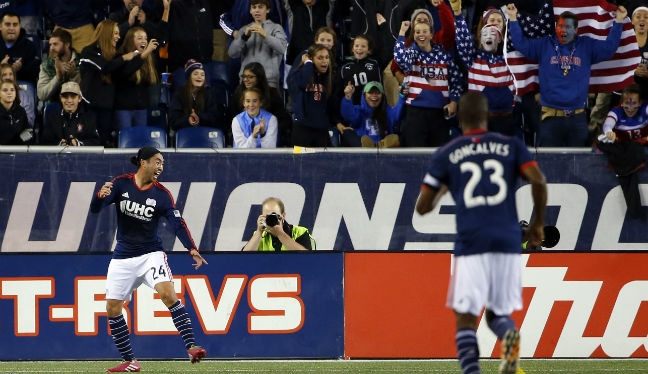Play of the Week 33: Offside calls in NE vs. TOR and CLB vs. PHI

Play of the Week 33 with PRO Training & Development Manager Paul Rejer looks at two goals that were scored, both in controversial circumstances due to the general perception that they should have been disallowed for offside.
And these goals would have indeed been given offside under the old offside law, until the new interpretation that commenced in season 2013/14.
This is under ‘Gaining an Advantage’ and the law states:
“Gaining an advantage by being in that position” means playing a ball that rebounds, is deflected or is played to him from a deliberate save by an opponent having been in an offside position. A player in an offside position receiving the ball from an opponent, who deliberately plays the ball (except from a deliberate save), is not considered to have gained an advantage.”
Rejer said: “The plays in question are at New England Revolution versus Toronto FC at 34:50, when the only goal of the game was scored by the Revs, and at Columbus Crew versus Philadelphia Union at 89:53, when Crew scored the winning goal.
“First, the New England goal: Chris Tierney was in an offside position when team-mate Jose Goncalves passed the ball in his direction. Defender Domininic Oduro headed the ball to Tierney. When Tierney played the ball, AR Matthew Nelson, who perhaps understandably did not see Oduro’s header from his distance, and who was concentrating on the kicker and the receiver of the ball, raised his flag to indicate an offside offense.
“Immediately astute and aware, referee Ricardo Salazar tells the AR that in fact the ball was headed to Tierney by Toronto’s Dominic Oduro. Nelson reacts quickly and lowers his flag. Tierney then passes the ball back to Lee Nguyen who scores the only goal of the game.
“There are two considerations:
1. Was the header by Oduro a deliberate play or a deflection? As his head goes towards the ball it has to be regarded a deliberate play. If he remains stationary and the ball hits him and goes to Tierney, then that is a deflection.
2. Did the Toronto defenders stop when they saw the flag? Yes, but they should not have. Players should know that they play to the whistle, not the flag.
“This was a valid goal and extremely good officiating, particularly by Salazar. We have been advising our referees that they should take responsibility for offside interpretation calls and not automatically, blindly, accept an AR’s raised flag.
“Second, the Columbus goal: After an exchange of passes between Crew’s Waylon Francis and Tony Tchani, Francis has a shot on goal which goes into the path of Union defender Maurice Edu.
“His foot goes towards the ball which is played directly to Philadelphia’s Bernado Anor, who inadvertently plays the ball to Columbus’ Bernado for a tap-in.
“There are two considerations:
1. Was this a deliberate play by Edu? This one is not as obvious as the first example. However you can see movement towards the ball by the defender. The ball did not go where he intended but it was not a deflection; the movement towards the ball is a play.
2. Unlike the first example, AR James Conlee has a clearer view of the involvement of Edu, so does not raise his flag. Conlee informs referee Ismail Elfath of the offside position of Anor and that in his opinion it was a deliberate play and therefore a good goal. Elfath agrees and awards the goal.
“Again, we have a valid goal and an example of good officiating with effective communication between the referee and his AR.
“These plays are often described as ‘jigsaw situations’, when the AR from his position has one piece of the information: the fact that the player is in an offside position. And the referee, from his position has the other piece of the jigsaw: deliberate play or deflection.
“After putting the two pieces together, the correct decision is achieved – the ultimate goal and objective of excellent and efficient teamwork.”
